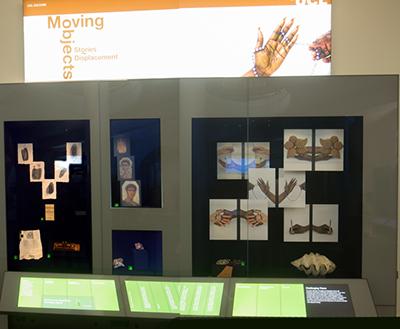A Selection of News from the Institute
Launch of new IoA Digital Heritage and Virtual Reality Laboratory
Rodney Harrison and Gai Jorayev
r.harrison@ucl.ac.uk
g.jorayev@ucl.ac.uk
Following a successful bid to faculty for strategic investment in new equipment, we launched the IoA Digital Heritage and Virtual Reality Laboratory in Term 1 2018–2019 academic year. The lab contains a range of Virtual and mixed/augmented reality equipment including Oculus Rift and Microsoft Hololens headsets. Additionally, there are two VR ready portable PCs, several tablet devices, Multispectral Cameras, two professional grade Unmanned Aerial Vehicles (UAV) and software for processing the data from photogrammetry applications (Figure 1). It occupies a dedicated space off the IoA’s existing photography suite, and the lab and equipment is available for research and teaching use.
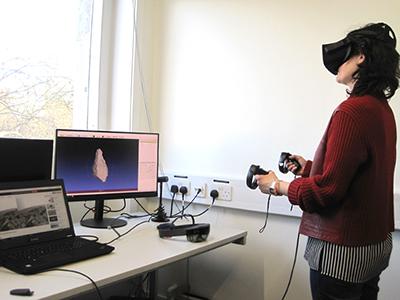
VR googles in use in the IoA Digital Heritage and Virtual Reality Laboratory (Photo: Carmen Martin Ramos).
A dedicated open day on the 22nd February 2019 showcased the equipment to the wider IoA community, and led to demonstrations for post-graduate student groups and staff members. Within a short period of time, several student groups successfully used the equipment and lab space for their course work. Students studying for the MA in Managing Archaeological Sites used the equipment extensively, particularly as part of the course’s Applied Heritage Management module where real-life, practical documentation, condition assessment and interpretation work is done in The House Mill, a Grade I listed building on the River Lea in East London. Students of the MA in Principles of Conservation are currently using the equipment and expertise of the lab for several of their ongoing projects in documentation and analysis of change in historical buildings and archaeological objects (Figure 2). A group of MA Museum Studies students were able to use the equipment to develop the exhibition project currently installed in our in-house Leventis Gallery. Wider collaboration with the Institute’s Conservation, Lithics and Photography laboratories is also shaping up. An ever-increasing number of enquiries from staff and students on possible uses of the laboratory and equipment shows that this endeavour is very timely.
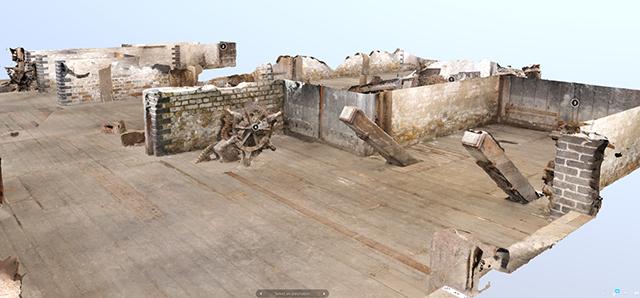
Ground floor of the House Mill photogrammetrically modelled and annotated to allow virtual tours (Photo: Gai Jorayev).
In addition to its use for teaching, a number of research projects have made use of the laboratory over the past year, including the IoA’s new Central Asian Archaeological Landscapes (CAAL) project. Multispectral cameras with UAV’s were used in two major international archaeological sites – Ancient Merv in Turkmenistan and Butrind in Albania. There were several test cases within the UK, as part of the Institute’s ongoing research initiatives. There is a scope for larger scale integration of methodologies developed in the Digital Heritage laboratory into workflows of our contracts division, Archaeology South-East (ASE). Specialists at ASE already use large-scale digital documentation with continuous investment into digital infrastructure, but some of the cutting edge experiments of the Digital Heritage laboratory, sometimes even involving the data generated by ASE teams, may accelerate the process and provide a competitive advantage. Potential collaborations with UCL Culture are also shaping up involving modelling and virtual reality presentations. We are currently discussing several projects with some of the most iconic heritage sites in London in order to model the structures, monitor the change and improve the interpretations with issues of accessibility in mind and possibility of presenting richer detail. Additional software packages are being acquired now as part of the research project funding streams and fantastic support from Information Services Department specialists continues to be crucial.
The Institute has a long track record of participation in pioneering technological solutions to modelling, analysing, and visualising archaeological datasets, often within particular research projects or in collaboration with external partners. The Digital Heritage lab provides internal support for these initiatives, and will further contribute to the establishment of dedicated courses on Digital Heritage and Digital Documentation.
Institute of Archaeology publication news
Papers from the Institute of Archaeology transfers to UCL Press
Chloë Ward
chloe.ward.11@ucl.ac.uk
ioa.pia-editor@ucl.ac.uk
Papers from the Institute of Archaeology (PIA) is a fully indexed, blind peer reviewed journal run out of the UCL Institute of Archaeology. The journal is almost entirely run by postgraduate students from the Institute who manage all aspects of the publication process; from creating calls for papers, to organising peer-reviews and copyediting. This gives the members of the editorial team significant experience of all stages of the editing process, which is invaluable to their future career. It also helps them gain better clarity of the publication process, useful for publishing their own research during or after their PhD. The journal publishes research papers and book reviews on all areas of archaeology, heritage, museum studies, and conservation. We have a particularly strong focus on early career research and specialise in helping authors publish their first academic papers. We publish online as soon as articles are ready, so there is no delay in research being released and submissions can be sent throughout the year.
Over the past year PIA has gone through an exciting development by transferring publishers to UCL Press, the first fully open access university press in the UK (https://www.uclpress.co.uk/). Through them we can continue to publish fully open-access research papers without incurring any charges to either the authors or the journal itself. As an early career open-access journal PIA has in the past struggled with waiving fees and APCs (Article Processing Charge) for our authors. While many Universities, particularly in the UK, cover these fees for associated staff and students, others do not. As such many academics, especially immediately after their PhD studies, are often faced with paying large fees in order to publish their research in an open-access format. At this crucial stage of their career they find themselves unable to cover the cost of these publications which are so important for their future. This makes UCL Press the perfect publication model for PIA which means that we can now publish all papers in an open-access format, free of charge.
The move to UCL Press is an exciting prospect for the future of PIA which allows us more flexibility in our publication model. We will continue to emphasise open-access and early career research but are also looking at developing more innovative approaches to our publishing in the future. This includes alternative output models such as podcasts, as well as developing a conference proceedings section. This also gives us the ability to easily publish work from international colleagues and showcase the significant variety of archaeological and heritage research taking place across the world, as well as from the Institute of Archaeology. Now reaching its 30th year of publication, PIA continues to be run by a team of dedicated graduate researchers supported by our reviewers and staff at the Institute, and now UCL Press, with whom we look forward to having a long and fruitful relationship.
You can find current and future editions of PIA on our new website at http://ojs.lib.ucl.ac.uk/index.php/PIA and follow our twitter feed on @piajournal.
Launch of the UCL Institute of Archaeology PhD Series
Ruth Whitehouse
r.whitehouse@ucl.ac.uk
The Institute of Archaeology has recently launched a new partnership with BAR Publishing to publish final revised PhD theses, to be known as the UCL Institute of Archaeology PhD Series. Its aim is to offer rapid publication of largely unaltered PhD theses. It covers the full range of subject areas studied at the Institute, including world archaeology, archaeological science, cultural heritage, conservation and museum studies. It makes data, analyses and interpretation available promptly to a wide audience.
This series is in the tradition of some continental universities, which publish PhD theses as a matter of course. This has not been normal practice in the UK, where it is more common for authors to publish their revised theses as academic monographs, or as a series of journal articles. However, for some people rapid publication is a priority, in which case this series may be for them. Publication in this format is quick (normally six to eight weeks after a contract is signed with BAR) and financially neutral, both for the authors and for the Institute: no subsidies are required, and no royalties are paid.
The series is administered by the IoA Publications Committee, like the two series that the Institute publishes with Routledge (the General Series and the Critical Cultural Heritage series). However, we do not put applications for the PhD series through the full refereeing process that we use for our other series, since we regard the successful completion of the PhD as sufficient indication that it is worthy of publication. Instead the Committee scrutinises the proposal and a brief report is prepared for BAR, a process normally completed quite rapidly after receipt of the application.
As well as providing opportunities to publish to our PhD students, this series will benefit the Institute by advertising both the breadth of subject matter and the quality of our PhDs.
The first volume in the series, Pattern and Process in the Material Culture of Anglo-Saxon Non-elite Rural Settlements, by Hana Lewis, has just been published (summer 2019).
Two further volumes have been accepted for publication – Ancient Maya settlement and the Alcanes Bajo: landscape and communities in the Three Rivers Region, by Gail Hammond and A Consideration of Gender Roles and Relations in the Aegean Bronze Age Interpreted from Gestures and Proxemics in Art, by Susan Poole – and others are currently under consideration.
Trial by Fire Conference 2019
Lisa Monetti and Kate Gafner
lisa.monetti.16@ucl.ac.uk
katrina.gafner.14@ucl.ac.uk
Fire represents one of the most powerful forces in the archaeological record, and what is left after a trial by fire can be used to understand the process of transformation. Though few archaeologists focus their research on fire and its presence in the archaeological record directly, it is a thread that runs through multiple archaeological subfields and further academic interest has been devoted to the evidence it leaves in its wake.
The Trial by Fire conference was developed to address the theme of fire in archaeological research and beyond and to offer a place to discuss future collaboration between subdisciplines joined by the omnipresence of fire. The conference was organised by IoA PhD candidates Lisa Monetti and Kate Gafner and generously funded by UCL’s Institute of Advanced Studies Octagon Small Grants Fund, the Institute of Archaeo-Metallurgical Studies, the Institute of Archaeology, and Oxbow Books. From the 17th–18th May 2019, academics from a multitude of international institutions aimed to answer the following questions:
Can fire be considered an artefact?
How have people engaged with fire over the course of history?
What can the aesthetics of a thermally altered object tell us about the burning event?
How has the study of fire evolved within the literature? How can fire be harnessed as an experimental tool moving forward?
In total, there were over 75 attendees, 21 podium presentations and 8 posters. Students and professionals contributed towards the development of an interdisciplinary understanding of fire during thematic sessions, such as pyrotechnology, experimental archaeology, funerary archaeology, and the hearth. Topics within each session ranged greatly, from the earliest evidence of controlled fire-use, to fireplaces and households in Çatalhöyük, to the investigation of modern forensic fires. Following each session, a discussion occurred to offer active collaboration between different research veins. After the final discussion, attendees were treated to an exclusive tour of the Wolfson Archaeological Science Laboratory by Dr Mike Charlton and Ole Nordland of the IoA (Figure 3).
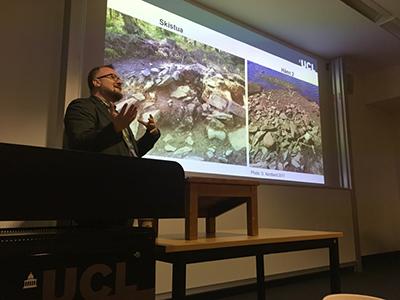
Ole Nordland, PhD candidate at the Institute of Archaeology, presenting on determining smelting temperatures from slag at the “Trial by Fire” conference (Photo: Lisa Monetti).
A wide range of presentations responded to the questions above, showing that fire can act as an artefact as the visibility of fire and its dynamic nature was highlighted. People were seen to have engaged with fire in a variety of ways throughout the course of history. Fire assumed many representative roles, whether it involved how a home or a city is built or the act of the cremation ritual. Changes to archaeomaterials also gave insight into the burning events, as fire was seen to leave characteristic marks across subject matters. Finally, the keynote presentations from Professor Tim Thompson of Teeside University and Dr Miljana Radivojević of the IoA presented overviews concerning how the literature and experiments surrounding fire have evolved and offered suggestions for where research should continue (Figure 4).
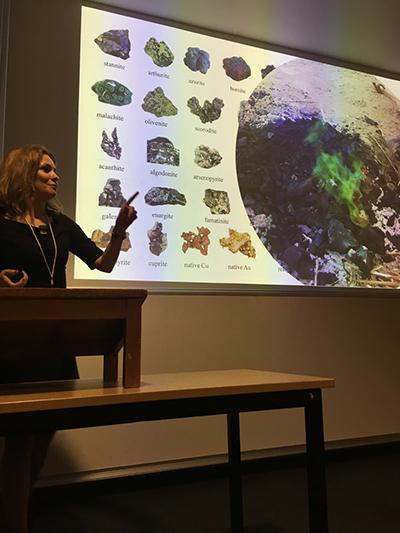
Dr Miljana Radivojević of the Institute of Archaeology delivering her keynote address at the “Trial by Fire” conference (Photo: Lisa Monetti).
At the conclusion of the conference, the benefits of multidisciplinary collaboration were evident. These conference conclusions and select papers will be published in the forthcoming proceedings, and this novel publication will provide a useful reference for other researchers studying fire, even tangentially. The full list of 2019 presenters and details about the forthcoming 2020 Trial by Fire conference can be found at trialbyfireteam.com.
Moving Objects – stories of displacement: UCL Octagon exhibition 18th February to 6th October 2019
Beverley Butler and Stephen Quirke
Beverley.butler@ucl.ac.uk
s.quirke@ucl.ac.uk
Some context – the official numbers (UNHCR 2019): “70.8 million forcibly displaced people worldwide”; 25.9 million refugees, including “5.5 million displaced Palestinian refugees under UNRWA’s mandate”; 3.5 million asylum seekers; “57% of UNHCR refugees came from 3 countries: Syria, Afghanistan, South Sudan”; “About 80% of refugees live in countries neighbouring their countries of origin”. What do people in London, including university staff and students, make of this? An unfortunate drop in the ocean of the 7.5 billion people on our earth? Or the iceberg tip glimpsed too late? In December 2018, the UN General Assembly endorsed a plan of action, the Global Compact on Refugees, which holds that responses are to be shaped by the refugees themselves and their hosts (UNHCR 2019: §34). The plan envisages networks of cities and municipalities, as well as a “global academic network” for new research and training.
This year the migration crisis debate arrived tangibly and materially at the heart of UCL, in the Octagon below its central dome, through an exhibition that seeks to convey the words and actions of the displaced. The display-case on Being in Place sets a base-line in the current ecological catastrophe, of endangered species and livelihoods, evoked in fish-trap and pangolin. The mood here is muted, a darker space punctuated by the animal bodies, select artefacts, and works on bright paper. Diametrically opposite, Challenging Views (Figure 5) confronts the starkest inhumanity of humans to each other, where the speaking subjects are those who have lived through torture. The Helen Bamber Foundation works with survivors of human cruelty; to say what we might not bear to hear, the students in its Photography Group (Helen Bamber Foundation n.d.) bring select museum artefacts underpinning colour pictures of hands holding those objects from their workshops. Beside the group contests the force of control represented by the fingerprint device of 19th-century UCL statistician Francis Galton (currently under another spotlight, in the history of eugenics inquiry: UCL News 2018). Fingerprints have been taken, but slightly blurred and so beyond individual recognition, rescuing the human subject from human machinery.
Out of Place relays the experience of refugee hosts in Lebanon and Jordan, through images and words, with poetry by Yousif M. Qasmiyeh. In one photograph, a Syrian man from the city of Daraa “gently holds his wife’s ring”, to the caption “he was informed by phone that his wife had died in childbirth. He was unable to bury his wife, and is unable to return to Syria to meet his child. ‘The ring is a part of me.’”. Below are items of jewellery from the Institute of Archaeology collections, from an ancient period of massive population movements. To the side are sayings for both ages in dialogue. “The food that is for one is enough for two”. “I would rather be welcomed than fed.”
Talking Objects (Figure 6) conveys the world of Palestinian refugee camps in Jordan from research by Beverley Butler (UCL Institute of Archaeology) and Fatima Al-Nammari (Petra University, Jordan) (see Butler 2018; Butler and Al-Nammari 2018). Across exile, home, land and dream, an enchanted kaleidoscopic landscape merges of contemporary objects and images interspersed with the evidence of archaeology, and of archaeologists – from the thobe garment “unique fingerprint of Palestinian heritage and identity” and the memory-tokens of Jerusalem, over the ground of the Jericho brick, to the Bethlehem Passport by Leila Sansour and Palestinian astronaut by Larissa Sansour. Central snapshots of paintings by Khalil Ghaith from Baqaa camp include the image of the elder woman beside the poem “Yearning” by Mahmoud Darwish, poet of Palestine.
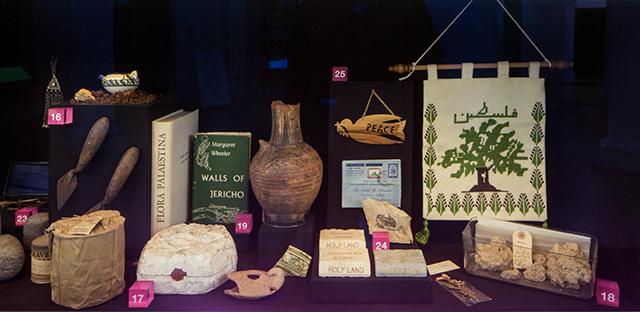
Palestinian material displayed in the Talking Objects case in the Moving Objects exhibition (Photo: Stuart Laidlaw).
Most archaeological material here comes from the Petrie Palestinian Collection, to which the Institute of Archaeology owes its existence, through the 1937 founding donation by Mary Woodgate Wharrie (Drower 1985: 379–380; Ucko 1998). A key site in that collection is Tell el-Ajjul, in the territory of Gaza, where eight camps now house one and a quarter million Palestinian refugees. What do people in London make of this? The Institute has special reason to respond.


